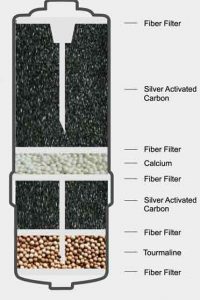Dirk S.: Are there water filter certificates which filter out “toxins”? and how is the pH increased so quickly (is something added to the water)?
Hello Mr. S.,
Your first question is general Filter and Water Ionizers.
So: You are unlikely to find water filter certificates because no laboratory issues such a thing. What you find are only exemplary analyzes of samples, which typically result in pollutant reduction values of between 90 and 99% for the individual substances.
This is typical for most known filter materials such as activated carbon granules, activated carbon blocks, aqualene activated carbon, ceramics, KDF, hollow fiber membrane, filter fleeces, which are integrated into the filters also installed in water ionizers. The basic rule is: In the first filter layers the larger pollutants and in the last filter layers the smaller pollutants are prevented from flowing further, like in an ever-closer-meshed grid. A reduction performance of 90% is usually stated because more cannot be measured, as there are lower limits of the usual laboratory methods. It can be even more precise using mass spectrometry, but that is unaffordable with over 1000 theoretically possible pollutants. So if you get a “filter certificate” from any manufacturer, they are a fraud. Water filter certificates
Because an analyzed sample is only a tiny part of the life of the filter. A filter needs the first 50 liters to run in. It then loses power until it reaches its capacity limit. This cannot be determined exactly either, because it of course depends on the filtration performance, which is defined solely by the water introduced.
If there are a lot of pollutants, the filter doesn't last as long as it does if there are a few. Therefore, the DIN regulation was set at a safe value of 6 months, after which a water filter should be changed. We know from almost 15 years of experience that many filters actually protect against pollutants for much longer if the water used does not have as many pollutants. But it's certainly not wrong to stick to this guideline, even if it occasionally hurts your wallet.
For multiple filter systems with 2 or more filter cartridges connected in series, we recommend changing at least the first filter cartridge after six months. The second then after a year, because it no longer gets as many pollutants.
Further downstream and even narrower-meshed filters then also filter all mineral ions out of the water, some of which are definitely desirable. This is called reverse osmosis. You can then add the desired minerals back in, which undoubtedly results in optimized drinking water. The reason why water ionizers do not work with such water is technical. To date, no reverse osmosis system has been able to generate sufficient water flow to operate a water ionizer.

Your second question is easier to answer: Is anything added to the water in the water ionizer?
The answer is: Yes, namely the electrons that come from the current supply to the electrodes in the Electrolytic cell be transferred into the water. However, these only end up in the alkaline part of the water produced by a water ionizer (i.e. the alkaline active water that we drink). Ultimately, these form neutral H2 gas from acidic H+ ions, which can dissolve in water up to an upper limit of 1,6 mg/l. This H2 gas is the energy storage that makes this water the most useful drinking water in the world today. Your question refers to the water from the water ionizer, where does the high pH value come from?
You need to know that the pH value is determined by the concentration of H+ ions. It corresponds to the same concentration of OH- ions when the water becomes neutral. If you now put a non-water-permeable membrane into the water, you separate H+ ions and OH- ions. If you still conduct an electric current through the water, the + or – charged ions gradually sort and accumulate in the two water chambers separated by the membrane. So what is added to the alkaline active water comes from the water itself. Alkaline active water from an ionizer does not require any other additives to work.
For more information, please read my book, available for free under Books www.euroultimedia.de for download.
Back to the topic of filters: One of our biggest pollutant ghosts is nitrate.
Most of today's filter systems cannot remove this from the water. There are special exchanger filters for this, but it usually remains in the drinking water, except for reverse osmosis filters. You should pay attention to this. The nitrate value is primarily an index value. Nowadays, nitrate itself can be seen as beneficial to health because it enables the release of nitric oxide (NO), which reduces elevated blood pressure in particular and is a very important dietary component. Therefore, the foods richest in nitrates, such as beetroot, spinach or lettuce, are also considered to be health-promoting.
The problem with nitrate-rich drinking water is not the nitrate, but rather the agricultural components that are normally present, such as pesticides, herbicides, hormones, drug residues, etc. Where there is a lot of nitrate in the water, these harmful substances can usually be suspected. Therefore, with activated carbon filtration technology, we strive to filter nitrate-rich water for its by-products, which we usually find in the organic range under the organic total TOC. Most water filters pass nitrate itself, as well as calcium, magnesium, potassium and sodium, because it is more beneficial than harmful.




